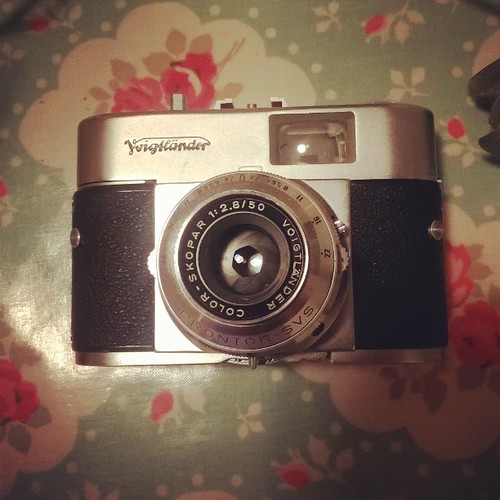If the Olympus Trip 35 became the classic P&S during the 60’s-70’s, that title was likely held by Voigtländer in the 50’s with this all time classic of German Engineering

Still a thing of beauty to hold and use today. This wonderfully engineered has picked up a classic tag. And for once it deserves but you need to pick your version wisely young Jedi.
Voigtländer is arguably the worlds longest living camera name. Johann Christoph Voigtländer began making scientific instruments in Vienna back in 1756 and his company would go on to be the longest lived camera manufacturing name in the world from their 1840 daguerreotype portrait camera (if you’re a camera geek worth noting this camera featured Josef Petzval’s lens) and went onto produce cameras well into the 20th century. Although actual Voigtländer production stopped some decades ago, the name remains in use under licence and you can still by Voigtländer lens today although sadly the last Voigtländer film camera rolled of the line this year although the Leica rivalling Bessa rangefinder is still available to buy new.
Voigtländer Vito B (late) specs
- Lens: 50mm Color-Skopar
- Focus: Scale
- Aperture: f/2.8-22
- Shutter: 1-1/300 +B
- Metering : None
- EV 100ISO: 3-17+
- Flash: PC sync
- Filter: Push on
The Vito B hails at the twightlight of the company’s Golden Age and launched in 1954. It is on one level a typical German viewfinder of its day. Non metered, well engineered, good optics with plenty of retro charm. But that does it a great dis-service. The lens is the famous fantastically sharp color-Skopar 4 element Tessar type cracker. The styling is timeless and exceedingly well finished.

11 Variants made. Earlier models featured a smaller viewfinder and are felt to be more aesthetically pleasing. Mines is one of the last Vito B and has the bigger viewfinder and bigger top-plate. It benefits from the faster f/2.8 lens and 9 speed (+B) prontor SVS shutter (although the more common 1/300 max version – a rare 1/500 version does exist). Some variants feature a slower f/3.5 lens and there are 3 different shutters types used (see camera-wiki.org’s page for more detail)

The bigger viewfinder is probably more practical but my only irritation is this later camera, unlike earlier models, uses a EV range coupled ring which I had on my Braun Paxette . You set the EV value you want (based on EV 100) and then select the shutter speed you want and this sets the appropriate aperture. I really don’t like this system as it can be confusing using EV100 values and non 100 ISO film and it can be a pain not having the ability to set aperture and shutter seperately. In hindsight I’d buy one without the EV ring.
But that is really the only irritation here. This one beautiful camera – incredibly well & stylishly put together even by German standards. And that lens… It truely deserves its classic tag and in the non EV coupled version probably was one of the sexiest cameras ever made. The lens for 50’s uncoated *optics is incredibly sharp and contrasty. (*see comments below)

You have a timer (avoid as ever in vintage cameras), cable point and PC sync with X & M settings. The X is the one for electronic flashes and you can sync at all speeds with an electronic flash.
A few quirks to note. The camera has a truly beautiful film compartment opening and rewind mechanism. The film counter is set manually (via a disk on the base just behind the lens) and counts down not up. It also doesn’t cock unless film is loaded meaning that many get dismissed as non functioning (this might allow you to get as a bargain – open the back and gentle move the sprocket wheel above the film plane to cock and check). The attention to detail is astounding – one of the best is the small spike beneath the lens barrel to keep stable if sat down.
A quick glance on eBay would suggest with a bit of luck you might get one for less than a tenner with some examples going up to about £30. The smaller viewfinder and f/2.8 lens do better.
Why Buy ?
- The lens
- Build quality & Style
- A true classic
Why not ?
- EV ring on late model
- Not metered
- Erm…
What I Paid
- Paid £12.69 plus postage for this with case on eBay
Alternatives
- Franka 125 – a simpler but fun early 60’s German P&S
- Braun Paxette – Well engineered but flawed Germanic P&S
- Halina Paulette – Haking’s Hommage/rip off of German cams
Helpful links
- Vito B page at Camera-wiki.org
- Voigtlander Vito Series manuals at Mike Butkus’s site
- Vito B Review on Matt’s Classic cameras
- Vito B Review at 35mmc

Hi, A nice little overview. There really isn’t that much to say about this well built, but ultimately simple camera. It just works and provides excellent negs, if properly exposed.
Are you sure your lens isn’t coated? It won’t be multi-coated, but lenses of that era on a camera of this quality will have a single coating, what we old stagers referred to then as “bloomed”. It has a light blue look to it. All my Voigtlanders, Vito B (small v/f), Vito IIa, Vitessa T, and Dynamatic II all have bloomed Color Skopars. This is why I am curious about your comment.
Hi Terry
I can’t be sure to be fair. I’ve looked again and no obvious cast on direct viewing but the reflection of the light shows up as both orange and as blue. Not sure if just a prisim effect or a very thin coating
Yes, that is the coating. As you can see it isn’t as obvious as modern day coating. In its basic form and viewed in daylight the first coated lenses or”bloomed” that started to appear after WWII will have a light blue caste.